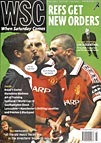 Preston were the first League champions in 1889 and still a force in the Fifties but, as Dave Russell describes, they have struggled to live up to their history ever since
Preston were the first League champions in 1889 and still a force in the Fifties but, as Dave Russell describes, they have struggled to live up to their history ever since
Preston North End have entered the new century in good shape, with a squad that finally looks good enough to end two decades in the League’s lower divisions. The name of manager David Moyes now invariably features in any press speculation about Premiership vacancies and under chairman Bryan Gray, Deepdale has been partially but dramatically redeveloped.
At the end of this year, the FIFA/FA-backed Football Museum opens in spacious accommodation under the new Sir Tom Finney and Bill Shankly stands. With average attendances running at over 12,000, North End are the best-supported club in the Second Division. Add to this the struggles of despised Blackpool and the future looks bright.
Yet while North End’s board can take pride in a well thought-out youth policy and a refreshingly long-term view, the club seems to spend almost as much time wrestling with its past as its future. Preston’s remarkable record in the earliest years of professional football – double winners in the Football League’s first season, champions again in 1890 and runners-up in the next three years – guarantees the club a special place within the game. It also makes Deepdale absolutely the right home for the Football Museum, whatever some metropolitan journalists might think.
But these early successes too often hide the fact that the club’s achievements at elite level have been limited, with FA Cup success in 1938 the single major honour since the 1890s. There have been lots of near misses, especially in 1953, when only goal difference separated North End from Arsenal at the top of the First Division, and in 1964, when, as a Second Division side, they were unlucky to lose an unusually good FA Cup final to West Ham.
However, the club hasn’t been in the top flight since 1961 and its later 20th century history has been thin indeed. Despite their many problems, the other Lancashire town clubs, severely weakened by the abolition of the maximum wage and the rise of super-clubs, have all done better on balance. Blackburn, Bolton and Burnley have all had their moments since the Sixties, and even Blackpool are never forgiven for a victory in 1970 which took them briefly back into the First and dropped Preston into the Third.
At this crucial moment of modernisation, a very distinctive and well-constructed version of the club’s history is being presented to the world. The Victorian legacy has been well mined, with the Invincibles Lounge gracing the Finney Stand, while Bryan Gray has skilfully tried to connect early glory with current developments.
Interviewed in David Conn’s The Football Business, he argues that the club’s “very rich history” provides core values of “longevity and success. This can be reflected in merchandise which spectators feel proud to buy.” Actually, the club’s merchandise is very good but antiquity of itself cannot confer quality in the way Gray implies – obviously he’s never bought souvenirs in Rome.
Above all, there is Sir Tom Finney. He is much to the fore at all club events; the road past the ground has been renamed after him; and the award-winning stand that bears his name also has his face picked out in coloured seats. A statue based on the famous “splash” photo of Finney at a waterlogged Stamford Bridge in 1956 will grace the museum entrance.
None of this is to criticise Finney or the club, for he thoroughly deserves these accolades and it is cheering to see respect preferred to shameful neglect. Finney spent his whole career with his home-town club – although he would have gone to Palermo in 1952 if North End had released him – and then remained in Preston to run a successful business and make a huge contribution to civic life as a magistrate, chairman of the local health authority and much else.
Finney is also famously and genuinely modest, a man quietly aware of his own worth but respectful of other people’s lives and achievements and he is loved in the town because of it. It’s significant that the local campaign for his knighthood, which was finally granted in 1998, was spearheaded by two teenage girls born more than 20 years after he retired. However, there is no denying that his high profile has allowed the club to trade extensively on a second “glorious” era, coating North End’s post-1945 history with an aura of success that the statistical record does not entirely support.
Given the economics of contemporary football, Preston’s most realistic hope is for a long-term berth in the First Division with the odd excursion into the Premiership. Whichever route they follow, though, Preston need to cultivate new heroes. The old ones are admirable, but they can’t score goals and the weight of history tends to pull down rather than up.
From WSC 157 March 2000. What was happening this month